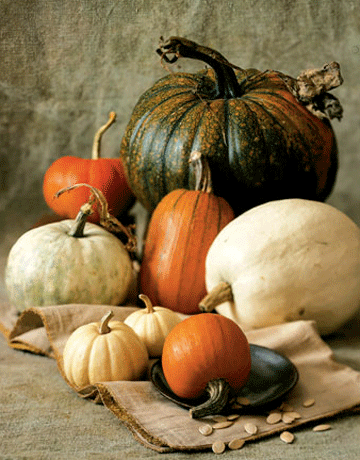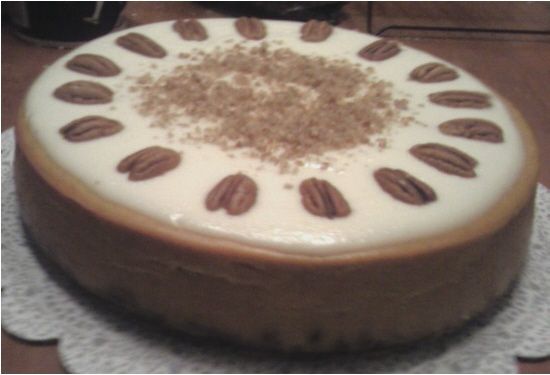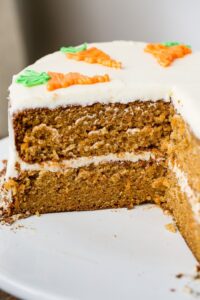Samhain is one of the eight festivals of the Wiccan/Pagan Wheel of the Years that is celebrated as the new year with the final harvest of the season. It is considered by most practitioners of the craft to be the most important of the eight Sabats and one of the four fire festivals, Imbolc, Beltane …
Tag: Halloween
Oct 28 2020
What’s Cooking: Carrot Cake
No one knows where of when carrot cake originated and there are as many stories as there are recipes for this favorite moist cake. It may have originated with carrot pudding, in the Middles Ages when sugar and sweeteners were hard to find or too expensive. Carrots have been long been used as as sweetener. …
Oct 31 2019
Samhain: The Thinning Of The Veil
Samhain is one of the eight festivals of the Wiccan/Pagan Wheel of the Years that is celebrated as the new year with the final harvest of the season. It is considered by most practitioners of the craft to be the most important of the eight Sabats and one of the four fire festivals, Imbolc, Beltane …
Oct 31 2018
Samhain: The Thinning Of The Veil
(Note: TMC is unavailable to post this so she asked me to do it instead.- ek) Samhain is one of the eight festivals of the Wiccan/Pagan Wheel of the Years that is celebrated as the new year with the final harvest of the season. It is considered by most practitioners of the craft to be …
Oct 31 2017
Samhain: The Thinning Of The Veil
Samhain is one of the eight festivals of the Wiccan/Pagan Wheel of the Years that is celebrated as the new year with the final harvest of the season. It is considered by most practitioners of the craft to be the most important of the eight Sabats and one of the four fire festivals, Imbolc, Beltane …
Oct 31 2016
Samhain: The Thinning Of The Veil
Samhain is one of the eight festivals of the Wiccan/Pagan Wheel of the Years that is celebrated as the new year with the final harvest of the season. It is considered by most practitioners of the craft to be the most important of the eight Sabats and one of the four fire festivals, Imbolc, Beltane …
Oct 31 2014
Samhain: The Thinning Of The Veil

Samhain is one of the eight festivals of the Wiccan/Pagan Wheel of the Years that is celebrated as the new year with the final harvest of the season. It is considered by most practitioners of the craft to be the most important of the eight Sabats and one of the four fire festivals, Imbolc, Beltane and Lughnasadh. Beginning at sundown on October 31 and continuing through the next day, fires are lit and kept burning to recognize the shortening of days and the coming of winter’s long cold nights.
Many of the traditions practiced in the US have come from Ireland, Scotland and Whales. The carving of gourds and pumpkins used as lanterns, the wearing of costumes and masks, dancing, poetry and songs, as well as some traditional foods and games can be traced back to medieval times and pre-Christian times.
Two Roman festivals became incorporated with Samhain – ‘Feralia’, when the Romans commemorated the passing of the dead, and ‘Pomona’, when the Roman goddess of fruit and trees was honoured. The Halloween tradition of bobbing for apples is thought to derive from the ancient links with the Roman fruit goddess, Pomona, and a Druidical rite associated with water.
It is also the time of the year that we reflect and honor our ancestors and especially those who have departed since last Samhain. According to Celtic lore, Samhain is a time when the boundaries between the world of the living and the world of the dead become thinner, allowing spirits and other supernatural entities to pass between the worlds to socialize with humans. The fires and the candles burning in western windows are believed to help guide the spirits of the departed to the Summerlands. Like all Wiccan festivals, Samhain celebrates Nature’s cycle of death and renewal, a time when the Celts acknowledged the beginning and ending of all things in life and nature. Samhain marked the end of harvest and the beginning of the New Celtic Year. The first month of the Celtic year was Samonios – ‘Seed Fall’.
The Catholic church attempted to replace the Pagan festival with All Saints’ or All Hallows’ day, followed by All Souls’ Day, on November 2nd. The eve became known as: All Saints’ Eve, All Hallows’ Eve, or Hallowe’en. All Saints’ Day is said to be the day when souls walked the Earth. In early Christian tradition souls were released from purgatory on All Hallow’s Eve for 48 hours.
We decorate our homes with candles, gourds and dried leaves. Meals are traditionally lots of veggies, fruit, nuts and breads served with wine, cider and hearty beer. We make a hearty stew that is served with a whole grained bread and deserts made with apples, carrots and pumpkin. One of the sweet breads that is traditionally served is barmbrack, an old Irish tradition. The bread is baked with various objects and was used as a sort of fortune-telling game. In the barmbrack were: a pea, a stick, a piece of cloth, a small coin (originally a silver sixpence) and a ring. Each item, when received in the slice, was supposed to carry a meaning to the person concerned: the pea, the person would not marry that year; the stick, “to beat one’s wife with”, would have an unhappy marriage or continually be in disputes; the cloth or rag, would have bad luck or be poor; the coin, would enjoy good fortune or be rich; and the ring, would be wed within the year. Today, the bread usually contains a ring and a coin.
What ever you believe or not, Samhain has meaning for us all since the Wheel turns for all of us. So light a fire or a candle and dance with us as the Veil Thins.
As I went out walking this fall afternoon,
I heard a wisper wispering.
I heard a wisper wispering,
Upon this fine fall day…As I went out walking this fall afternoon,
I heard a laugh a’laughing.
I heard a laugh a’laughing,
Upon this fine fall day…I heard this wisper and I wondered,
I heard this laugh and then I knew.
The time is getting near my friends,
The time that I hold dear my friends,
The veil is getting thin my friends,
And strange things will pass through.
Blessed be.
Oct 30 2014
Pumpkins, Not Just For Carving
Re-posted from October 22, 2011
When most of us think of pumpkins, we think of the orange orbs that get carved up for Halloween and pumpkin pie with gobs of whipped cream for dessert at Thanksgiving but pumpkins come in all shapes, colors, sizes and varieties. Some are good only for decoration, while others are not only decorative but very tasty in pies, soups and stews.
 According to Wikipedia pumpkin “is a gourd-like squash of the genus Cucurbita and the family Cucurbitaceae (which also includes gourds). It commonly refers to cultivars of any one of the species Cucurbita pepo, Cucurbita mixta, Cucurbita maxima, and Cucurbita moschata, and is native to North America.” Some of the fun activities besides decorative carving for Halloween are Festivals and competitions with pumpkin chucking being among the most popular. Chucking has become so popular that some competitors grow their own special varieties that will survive being shot from catapults and cannons. The festivals are most dedicated to the competition for recipes and the competition for the largest pumpkin. This year that honor went to a 2058 pound beauty from Northern California will be on display this weekend at the Half Moon Bay Pumpkin Festival in San Francisco.
According to Wikipedia pumpkin “is a gourd-like squash of the genus Cucurbita and the family Cucurbitaceae (which also includes gourds). It commonly refers to cultivars of any one of the species Cucurbita pepo, Cucurbita mixta, Cucurbita maxima, and Cucurbita moschata, and is native to North America.” Some of the fun activities besides decorative carving for Halloween are Festivals and competitions with pumpkin chucking being among the most popular. Chucking has become so popular that some competitors grow their own special varieties that will survive being shot from catapults and cannons. The festivals are most dedicated to the competition for recipes and the competition for the largest pumpkin. This year that honor went to a 2058 pound beauty from Northern California will be on display this weekend at the Half Moon Bay Pumpkin Festival in San Francisco.
The pumpkin is one of the main symbols of Halloween and the Wiccan holiday of Samhain, which is a celebration of the end of the year, the final harvest and the coming of winter. The earliest that a craved pumpkin was associated with Halloween is 1866. Throughout Britain and Ireland the turnip has traditionally been used at Halloween, but immigrants to North America used the native pumpkin, which are both readily available and much larger, making them easier to carve than turnips.
In cooking, the the fleshy shell, seeds, leaves and flowers are all edible. Canned pureed pumpkin is readily available in stores, as are the small, sweet variety of fresh pumpkin for the ambitious cook to make their own puree or for stews. When it comes to pies, the easiest is the canned, my favorite being Libby’s with the recipe on the label, label, label. It’s the only recipe I have ever used for pumpkin pie and I’ve never has a complaint.
Pumpkin and all it parts are also very nutritious, containing many vitamins, minerals and anti-oxidents. There is also an interesting medical study of pumpkin extract on type-1 diabetic rats:
(P)ublished in July 2007, suggests that chemical compounds found in pumpkin promote regeneration of damaged pancreatic cells, resulting in increased bloodstream insulin levels. According to the research team leader, pumpkin extract may be “a very good product for pre-diabetic people, as well as those who already have diabetes,” possibly reducing or eliminating the need for insulin injections for some type-1 diabetics. It is unknown whether pumpkin extract has any effect on diabetes mellitus type 2, as it was not the subject of the study.
One of my favorite recipes is Pumpkin Cheesecake with Bourbon Sour Cream Topping that is more popular than pie with my family.

Recipe and baking tips are below the fold
Oct 29 2014
Samhain: The Thinning Of The Veil

Samhain is one of the eight festivals of the Wiccan/Pagan Wheel of the Years that is celebrated as the new year with the final harvest of the season. It is considered by most practitioners of the craft to be the most important of the eight Sabats and one of the four fire festivals, Imbolc, Beltane and Lughnasadh. Beginning at sundown on October 31 and continuing through the next day, fires are lit and kept burning to recognize the shortening of days and the coming of winter’s long cold nights.
Many of the traditions practiced in the US have come from Ireland, Scotland and Whales. The carving of gourds and pumpkins used as lanterns, the wearing of costumes and masks, dancing, poetry and songs, as well as some traditional foods and games can be traced back to medieval times and pre-Christian times.
Two Roman festivals became incorporated with Samhain – ‘Feralia’, when the Romans commemorated the passing of the dead, and ‘Pomona’, when the Roman goddess of fruit and trees was honoured. The Halloween tradition of bobbing for apples is thought to derive from the ancient links with the Roman fruit goddess, Pomona, and a Druidical rite associated with water.
It is also the time of the year that we reflect and honor our ancestors and especially those who have departed since last Samhain. According to Celtic lore, Samhain is a time when the boundaries between the world of the living and the world of the dead become thinner, allowing spirits and other supernatural entities to pass between the worlds to socialize with humans. The fires and the candles burning in western windows are believed to help guide the spirits of the departed to the Summerlands. Like all Wiccan festivals, Samhain celebrates Nature’s cycle of death and renewal, a time when the Celts acknowledged the beginning and ending of all things in life and nature. Samhain marked the end of harvest and the beginning of the New Celtic Year. The first month of the Celtic year was Samonios – ‘Seed Fall’.
The Catholic church attempted to replace the Pagan festival with All Saints’ or All Hallows’ day, followed by All Souls’ Day, on November 2nd. The eve became known as: All Saints’ Eve, All Hallows’ Eve, or Hallowe’en. All Saints’ Day is said to be the day when souls walked the Earth. In early Christian tradition souls were released from purgatory on All Hallow’s Eve for 48 hours.
We decorate our homes with candles, gourds and dried leaves. Meals are traditionally lots of veggies, fruit, nuts and breads served with wine, cider and hearty beer. We make a hearty stew that is served with a whole grained bread and deserts made with apples, carrots and pumpkin. One of the sweet breads that is traditionally served is barmbrack, an old Irish tradition. The bread is baked with various objects and was used as a sort of fortune-telling game. In the barmbrack were: a pea, a stick, a piece of cloth, a small coin (originally a silver sixpence) and a ring. Each item, when received in the slice, was supposed to carry a meaning to the person concerned: the pea, the person would not marry that year; the stick, “to beat one’s wife with”, would have an unhappy marriage or continually be in disputes; the cloth or rag, would have bad luck or be poor; the coin, would enjoy good fortune or be rich; and the ring, would be wed within the year. Today, the bread usually contains a ring and a coin.
What ever you believe or not, Samhain has meaning for us all since the Wheel turns for all of us. So light a fire or a candle and dance with us as the Veil Thins.
As I went out walking this fall afternoon,
I heard a wisper wispering.
I heard a wisper wispering,
Upon this fine fall day…As I went out walking this fall afternoon,
I heard a laugh a’laughing.
I heard a laugh a’laughing,
Upon this fine fall day…I heard this wisper and I wondered,
I heard this laugh and then I knew.
The time is getting near my friends,
The time that I hold dear my friends,
The veil is getting thin my friends,
And strange things will pass through.
Blessed be.
Oct 29 2014
Carving Pumpkins 101
Rather than try to explain how to carve a pumpkin here is a video that is a handy 5 minute guide.
And for the more ambitious and artistic pumpkin carvers among us, here is some inspiration with seasonal music.
- 1
- 2


Recent Comments